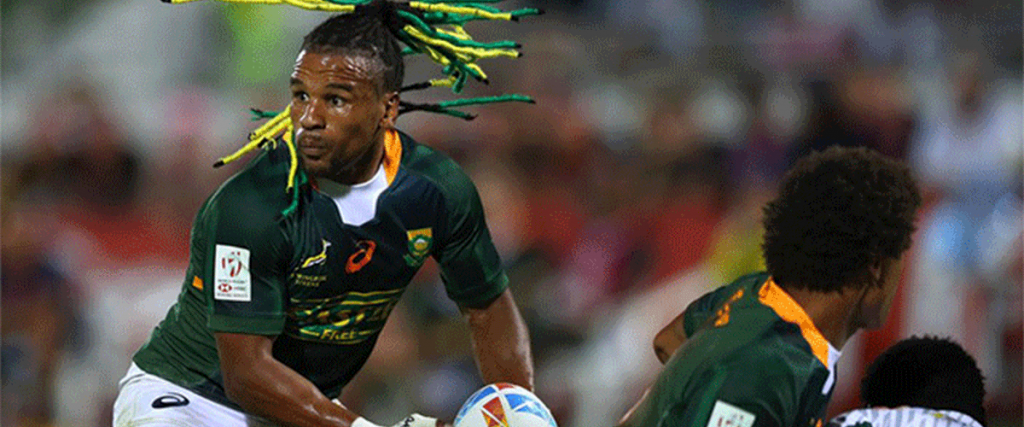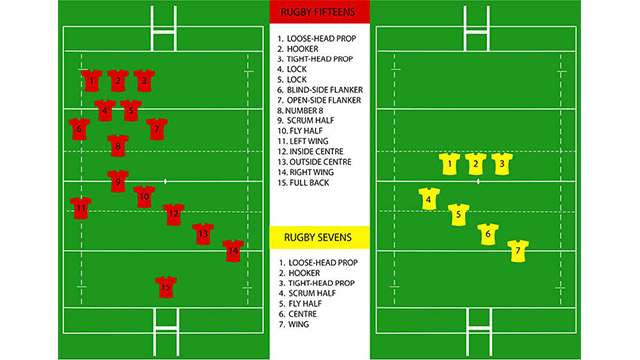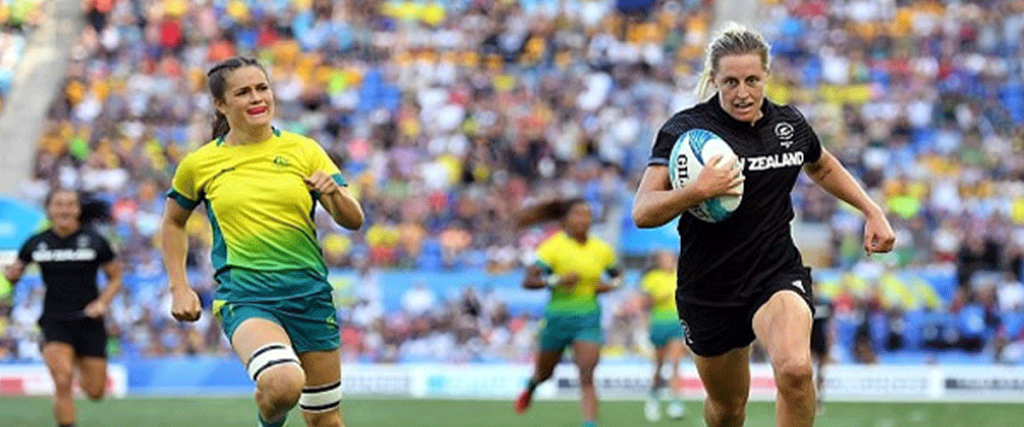What is Sevens Rugby?

Sevens Rugby, also known as rugby 7s or seven-a-side rugby, is a common variation of the 15 man game that draws strongly from Rugby Union. Both men’s and women’s rugby sevens is to be included in the 2016 and 2021 Summer Olympic Games.
With only seven players playing on a full size rugby field, sevens rugby is a faster-paced, more spread out version of 15-man rugby.
Sevens is one of the most pervasive forms of rugby, and is popular in countries such as South Africa, Kenya, Japan, the UK, Scotland, France, Australia, Fiji, Tonga, Argentina, Canada, Netherlands, Hong Kong, Malawi and New Zealand.
Sevens rugby is a specialist sport that requires specific skills and drills coaching. Sevens requires brute force coupled with explosiveness, fitness and feline agility. Most training drills for playing Sevens rugby focus on developing attack, defence and offence.
Players positions in sevens rugby

Rugby Sevens is regulated by the IRB. Positions are numbered as follows:
Starters
1) Prop
2) Hooker
3) Prop
4) Scrum-Half
5) Fly-Half
6) Center
7) Fullback
Bench
8) Prop
9) Hooker
10) Prop
11) Scrum-Half
12) Fly-Half
13) Center
14) Fullback
Only 5 subs may be brought to a game, and only 3 subs made per game.
Coaching 7s Rugby
As mentioned, sevens rugby is played on the same size field pitch as the 15-a-side game, though with only 7 players per side, not 15!
This means there is a lot more space for players to run, pass, kick, tackle and communicate. The sevens game also follows very similar rules to 15-aside rugby, and includes lineouts, scrums and penalties.
With only 14 players on the field, players must be fit and have high levels of skill in catching, passing, defending, rucking and evading.
Whilst there is more opportunity for individuals to shine in sevens, the modern sevens team still requires excellent organisation and cohesion to succeed, especially at an elite level.
Rugby Sevens Coaching Principles
The core principles for attack and defence are the same across sevens and rugby fifteens.
| Attack | Defence |
|---|---|
| 1. Gaining Possession | 1. Contesting Possession |
| 2. Going Forward | 2. Going Forward |
| 3. Supporting Team Mates | 3. Supporting the Defender |
| 4. Maintaining Continuity | 4. Applying Pressure. |
| 5. Creating Pressure to score Points | 5. Regaining Possession |
Sevens rugby attack tips

Gaining Possession
Firstly, your team needs to gain possession of the ball. If for no other reason, because we need the ball to score tries. The 3 recognised ways to gain possession are from scrum, lineout and kickoffs.
There is a belief amongst many coaches that scrums and lineouts are the most important set piece to practice. Read below for our view on why that is not the case:
- Scrums. On average, there are 4 scrums per game, which is a scrum every three-and-a-half minutes. Scrums are a crucial attacking platform in sevens, as they temporarily slow down 6 players (3 forwards on each team) from entering the fray. This means, on attack you have 4 vs 4, which given the size and space on a rugby field, should create many opportunities to break the defensive line and score points.
- Lineouts. On average, there are only 2 lineouts per game, let’s say one every 7 minutes. Nonetheless, like the scrums, a lineout pulls the forwards to one side of the field, leaving the attacking team with a lot of width to play with.
- Kickoffs. In sevens, the team that scores kicks off, unlike in the fifteen aside game. In other words, the team that concedes the try, receives the restart in sevens. On average, there are 12 kickoffs per game. As such, gaining possession from the kickoff is a vital team skill to practice.
As such, we recommend as a coach you prioritise training kick-offs. Then, focus on scrums followed by lineouts, as lineouts tend to happen least.
Going Forward
The goal of the attacking team is to score points. It does this by gaining possession of the ball (see above), then moving forward with the ball to create pressure and opportunities to penetrate the defence.
The attacking team (team with the ball), essentially has two complimentary options to consider on attack:
- Attack laterally, exploit space across the field e.g. when the attack outnumbers the defence.
- Attack linearly, by essentially closing the space down between your attack and the line of defence e.g. when the defence outnumbers the attack and you want to ‘suck in’ defenders.
The most common approach used by 7’s rugby teams is to attack space out wide, laterally. Linear attack is more often used in rugby 15s.
That said, with sevens a combination of linear and lateral attack often prevails, using a combination of the following four options:
- “Pull”, when the ball carrier pedals backwards, pulling the defence forward, to allow his team time to re-align or reset.
- “Power”, when the ball carrier decides to take contact, draw in a defender(s), to most often reset the attack from a ruck.
- “Drag”, this is when the attacker moves laterally to spread the defence out.
- “Swing”, this is when the ball carrier passes in a particular direction.
Supporting the ball carrier and your team
Supporting the ball carrier on attack is a critical requirement in sevens rugby. On attack and defence, your work “off the ball” or when you don’t have the ball is most often the factor that decides which team wins or loses.
On attack, when your team has the ball, you need to establish a mentality within your team of supporting the ball carrier to give him options with the off load, the line break and at rucks. For example, how often in 7s do we see a line break with the ball carrier being tracked down meters from the try line, to then have the ball turned over as there is no support player at the ruck or to take the off load.
As is always the case, support players need to learn how to align with linear and lateral accuracy e.g. if the player supporting the ball carrier is too wide (linear), then the offload of his pass may lack accuracy. Playing together as a team helps achieve the correct balance between linear and lateral support as does active communication between players.
For starters, we recommend you group your players on attack into three as follows:
- the ball carrier
- the player who passed the ball to the ball carrier
- the player who is in a position to receive the ball from #2
Let’s see how this would work in practice. Scenario 1: player #1 gets tackled, #2 also known as the “pocket player” or “post player”, comes in to secure the ball whilst player #3 comes in as halfback to receive the ball and continue the attack. Scenario 2: player #1 takes contact then offloads to #2, the “pocket player”, and the attack continues. Scenario 3: the ball carrier (#1) runs out of space and runs a cut with the “pocket” player (#2) who can then continue the attack.
Finally, fitness and conditioning helps a lot with support play, as work rate “off the ball” is such an important requirement.
Applying pressure
Rugby is a continuous tussle between the attacking team trying to create space and the defending team trying to limit the space of the attacking team.
For the defenders, the less time and space you give the attacking team the better. On the other hand, the more time and space the attacking team creates by disorganizing the defence, the greater the chance it will create space or a mismatch.
So how does the attacking team apply pressure to the defence?
The key focus here is to retain possession. With 7s, the key ways to pressurise the defence are as follows:
- creating quick ruck ball, allowing the defence less time to reset, thereby creating opportunities to attack
- changing direction, to confuse or split the defence
- aligning deep, for example if you need more time to execute a move, or aligning flat to give the defence less time to adjust
- playing with width to stretch the defence, this is particularly effective if the attackers outnumber the defenders, or playing narrow when, for example, you have less attackers than defenders or more physical ball carriers
- splitting the defence by, for example, setting up a ruck in the middle of the field to create open and blind side (narrow side) attacking options
- using tactical kicking, e.g. a grubber or punt, to turn the defence
- getting the defence to commit more players to the ruck or a tackle, thereby leaving fewer players to defend
